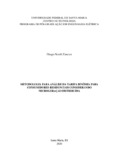| dc.creator | Zancan, Diogo Nardi | |
| dc.date.accessioned | 2021-10-14T19:04:16Z | |
| dc.date.available | 2021-10-14T19:04:16Z | |
| dc.date.issued | 2020-09-24 | |
| dc.identifier.uri | http://repositorio.ufsm.br/handle/1/22407 | |
| dc.description.abstract | In view of the continuous increase in the consumption of electricity in the country, due to the different climatic conditions due to the great territorial extension and the approximation of the maximum capacity of electric energy generation of its consumption, the electricity distributors were obliged to resort to thermoelectric plants to complement your amount of energy. Consequently, buying energy at a higher cost, being obliged to pass these values on to customers through the Tariff Flags, in addition to readjustments in the tariff itself. Concerned with the variation in the electricity tariff, many consumers have been looking for alternatives to reduce the economic impacts on their consumer units. Distributed microgeneration, in particular, photovoltaic solar energy is a relatively simple alternative and has been widely used by residential, commercial and even industrial consumers. The model known as net metering, used to regulate energy microgeneration systems in Brazil, together with the monomial tariff system, can generate a cross-subsidy between consumers from the same distributor. This phenomenon has generated discussions around the world, involving the application of a different tariff called binomial to microgenerators, in order to cover the fixed costs of distributors referring to these units. The eminent need for a revaluation of the tariff system due to new technologies implemented in the electricity sector, the proposed methodology considers a tariff model based on the maximum hourly demand, obtained by the load curves and divided by consumption classes. With data from typical homes, combined with the Hybrid Optimization Model for Eletric Renewables (HOMER) software, the main result is the technical and economic feasibility of applying the new tariff model, including data from consumers who own or intend to invest in Distributed Generation (GD). It should be noted that such analyzes are unprecedented in terms of the methodology developed and aim at financial balance between distributors and consumers. including data from consumers who own or intend to invest in Distributed Generation (GD). It should be noted that such analyzes are unprecedented in terms of the methodology developed and aim at financial balance between distributors and consumers. including data from consumers who own or intend to invest in Distributed Generation (GD). It should be noted that such analyzes are unprecedented in terms of the methodology developed and aim at financial balance between distributors and consumers. | eng |
| dc.language | por | por |
| dc.publisher | Universidade Federal de Santa Maria | por |
| dc.rights | Attribution-NonCommercial-NoDerivatives 4.0 International | * |
| dc.rights.uri | http://creativecommons.org/licenses/by-nc-nd/4.0/ | * |
| dc.subject | Microgeração distribuída | por |
| dc.subject | Modelo tarifário | por |
| dc.subject | Tarifa binômia | por |
| dc.subject | Distributed microgeneration | eng |
| dc.subject | Tariff model | eng |
| dc.subject | Binomial tariff | eng |
| dc.title | Metodologia para análise da tarifa binômia para consumidores residenciais considerando microgeração distribuída | por |
| dc.title.alternative | Binomic tariff analysis methodology for residential consumers considered distributed microgeneration | eng |
| dc.type | Dissertação | por |
| dc.description.resumo | Diante do aumento contínuo do consumo de energia elétrica no país junto as distintas condições climáticas devido à grande extensão territorial e a aproximação da capacidade máxima de geração de energia elétrica de seu consumo, as distribuidoras de energia elétrica foram obrigadas a recorrer às usinas termoelétricas para complementar seu montante de energia. Por conseguinte, comprando energia com custo mais elevado, sendo obrigadas a repassar estes valores aos clientes através das Bandeiras Tarifárias, além de reajustes na própria tarifa. Preocupados com a variação da tarifa de energia elétrica, muitos consumidores vêm procurando alternativas para reduzir os impactos econômicos em suas unidades consumidoras. A microgeração distribuída, em especial a energia solar fotovoltaica é uma alternativa relativamente simples e vem sendo amplamente utilizada por consumidores residenciais, comerciais e até industriais. O modelo conhecido como net metering, utilizado para regular os sistemas de microgeração de energia no Brasil, em conjunto com o sistema de tarifa monômia, pode gerar um subsídio cruzado entre consumidores da mesma distribuidora. Esse fenômeno tem gerado discussões ao redor do mundo, envolvendo a aplicação de uma tarifa diferenciada chamada binômia aos microgeradores, de forma a cobrir os custos fixos das distribuidoras referentes a essas unidades. A eminente necessidade de reavaliação do sistema tarifário devido as novas tecnologias implantadas no setor elétrico, a metodologia proposta considera um modelo tarifário baseado na demanda máxima horária, obtido pelas curvas de carga e divididos por classes de consumo. Com os dados de residências típicas, aliadas ao software Hybrid Optimization Model for Eletric Renewables (HOMER), tem como principal resultado a viabilidade técnica e econômica quanto a aplicação do novo modelo tarifário, incluindo dados de consumidores que possuem ou pretendem investir em Geração Distribuída (GD). Ressalta-se que tais análises são inéditas quanto a metodologia desenvolvida e visam o equilíbrio financeiro entre as distribuidoras e os consumidores. | por |
| dc.contributor.advisor1 | Bernardon, Daniel Pinheiro | |
| dc.contributor.advisor1Lattes | http://lattes.cnpq.br/6004612278397270 | por |
| dc.contributor.referee1 | Santos, Laura Lisiane Callai dos | |
| dc.contributor.referee2 | Garcia, Enoque Dutra | |
| dc.creator.Lattes | http://lattes.cnpq.br/6675831996094328 | por |
| dc.publisher.country | Brasil | por |
| dc.publisher.department | Engenharia Elétrica | por |
| dc.publisher.initials | UFSM | por |
| dc.publisher.program | Programa de Pós-Graduação em Engenharia Elétrica | por |
| dc.subject.cnpq | CNPQ::ENGENHARIAS::ENGENHARIA ELETRICA | por |
| dc.publisher.unidade | Centro de Tecnologia | por |



